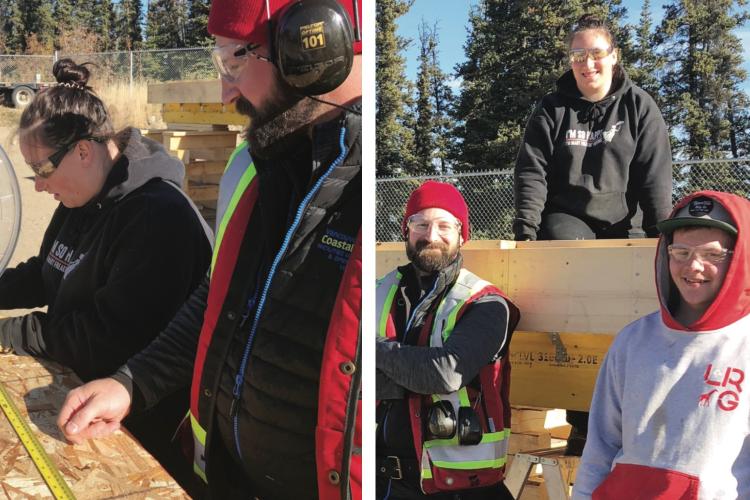Building stability, one day at a time

New partnership program gives youth the chance to learn and earn
MICHAEL GIRARD AND Shannon Holmes have been friends for life. They’ve known each other since elementary school, and now they’re both working in a new program called Building Stability.
It’s aimed at giving youth who have been involved with the justice system an introduction to basic carpentry and fundamental skills for employment by teaching them how to build a tiny house.
On a warm autumn afternoon, Michael, Shannon, and the other program participants are hard at work cutting boards to stabilize the house’s foundation. While they work, they banter back and forth and laugh a lot.
“It’s actually a pretty great program and it’s nice to have a friend around – it makes the day go faster,” Shannon says.
Shannon has been with the program since it began in August. Last year, she suffered a devastating concussion when she fell during a hockey game. She was halfway through her degree program at St. Francis Xavier University when it happened, and the injury forced her to put her studies on hold.
She came back home to Yukon to recover. And this program keeps her interested and engaged while she heals.
“I like to learn new things,” she says.
Shannon’s friend Michael entered the program on the recommendation of his probation officer. He dropped out of high school in Grade 10 and has been working at odd jobs ever since.
“School just wasn’t for me,” Michael says.
“Teachers didn’t like me, and I didn’t like teachers.”
For him, this program is a way to gain skills to further his prospects for finding employment and earn some money along the way.
“We’re learning a lot of different things. I’ve done carpentry in the past, but I have never built a house before,” Michael says. “It’s not like school was. It’s more laid back and our boss is pretty cool.”
The “pretty cool” boss is program instructor Keith MacPherson. He earned his carpentry apprenticeship through Yukon College’s trades program in the early 2000s and wrote his final exam in 2009. After graduating, Keith spent a few years working in Vancouver, but came back to Whitehorse to teach.
“While I was growing up in the Yukon, I definitely saw how society can fail certain people,” says Keith. “I saw where improvements were needed and it’s nice to come back and be able to do something good. I think what we’re doing is definitely a step in the right direction.”
Program participants earn a wage for every hour they spend working on the house. Keith also helps them with things like getting social insurance numbers and setting up bank accounts, so there can be a smooth transition into other jobs once the program is complete.
Just one month in, Keith has already seen results.
“I’ve certainly seen a change in people being up and ready to go,” he says. “It’s fantastic.”
Each day participants are picked up from home in the morning. The team has lunch together and then they are dropped back at home at end the afternoon. This structure gives Keith and the students a lot of time to get to know each other.
“I get a pretty good sense of what’s going on in peoples’ lives,” he says. “If people are feeling down or stressed, we can help them get through it. They might get more quiet time, if that’s what they need. Or if I see people getting frustrated, I find something else for them to do.
“My aim is to get people interested and excited about trying different trades.”
The program is delivered as a partnership between the Champagne and Aishihik First Nations (CAFN), Yukon Housing, the Government of Yukon departments of Justice and Education, and Yukon College’s Centre for Northern Innovation in Mining. Yukon Housing provided the materials to construct the house, and the Yukon government provided the salary for the instructor.
Once the structure is complete, it will be transported to Haines Junction to become crisis housing for CAFN citizens.
“The overall goal is to send a structure to Haines Junction that we can be proud of, but more than that, it’s to build people up,” says Keith. “We’re gaining momentum every day and I am excited to see what people do after this program.”